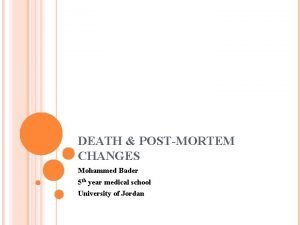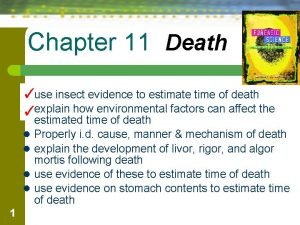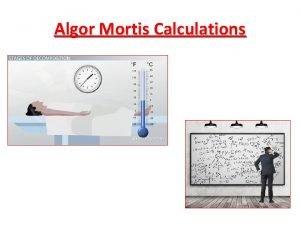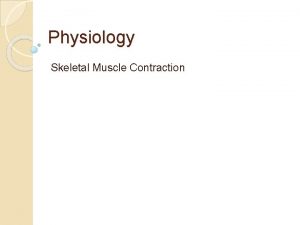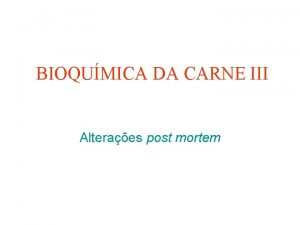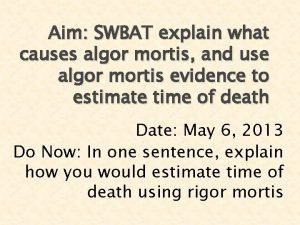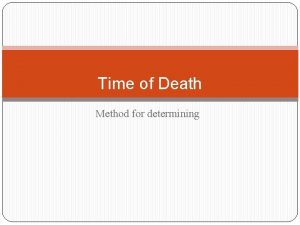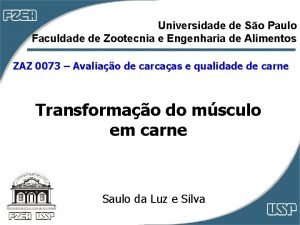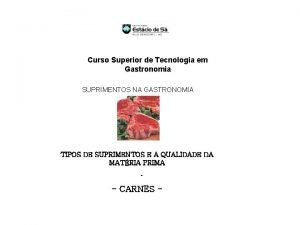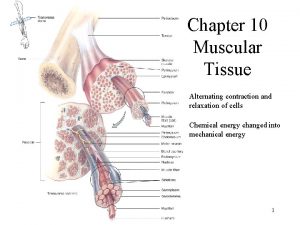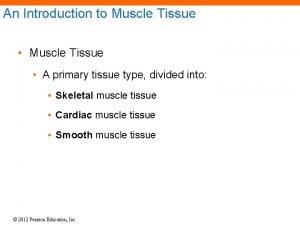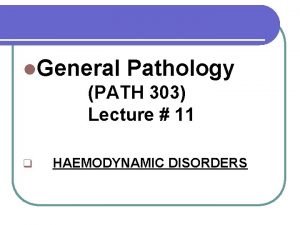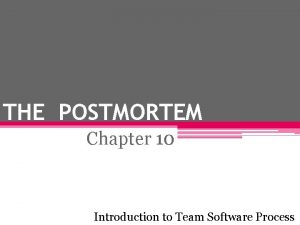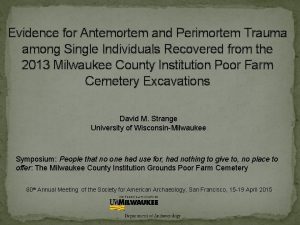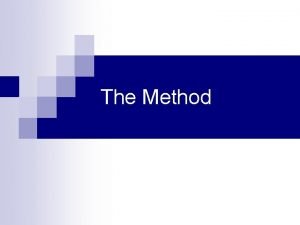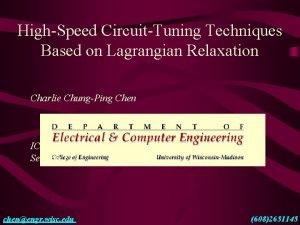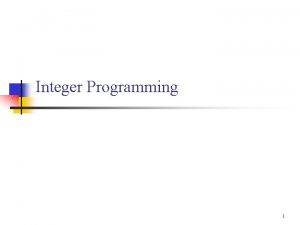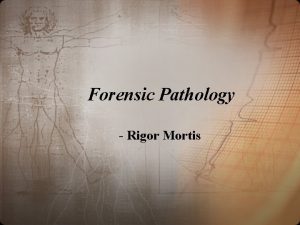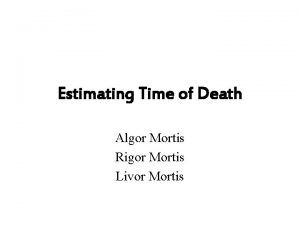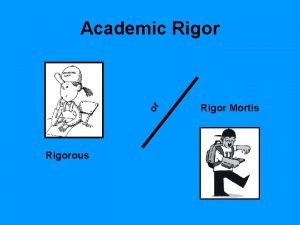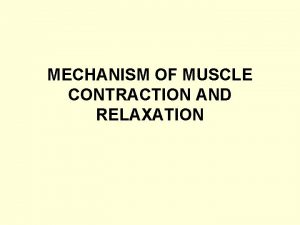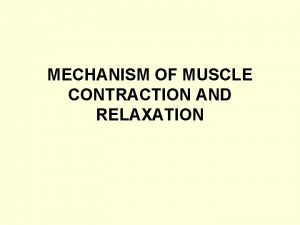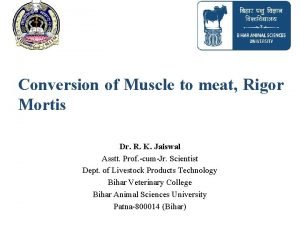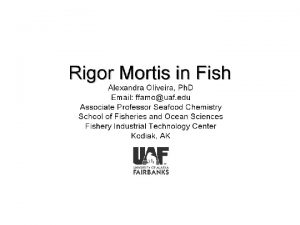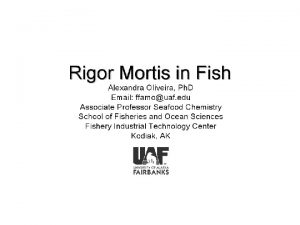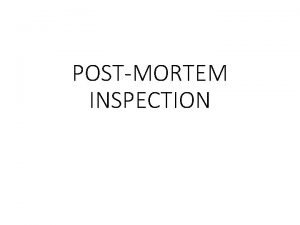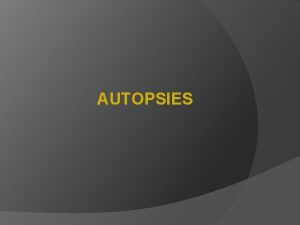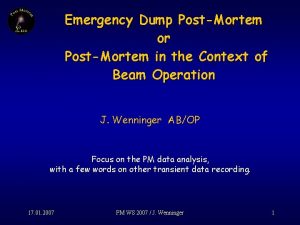POSTMORTEM CHANGES q Contraction relaxation q Rigor mortis






























- Slides: 30

POSTMORTEM CHANGES q. Contraction & relaxation q. Rigor mortis. q. Lowering PH value q. Lowering water holding capacity. q. Conditioning/ aging of meat q. Tenderness q. Toughness

Contraction and relaxation: During life: All vital processes demands energy(Cal). The required energy obtained from oxidation of the nutrients, protein, fat & CHO, giving rise to elements which are required for building up or repairing tissue cells& other end products which are not required & excreted outside the body as; CO 2, H 2 O, urea, uric acid & ammonia.

The Adenosin triphosphoric acid is one of the most energy stored substances which play an important role in storage & production of the energy. It composed of:

It is present in the tissues of living body, at PH 7. 0 form salt, Adenosine triphosphate “ATP" which is present in high concentration in muscle(every 100 gm muscle contain 350 mg ATP), every 24 hr, the amount of ATP reaches about 70 kg. Contraction Relaxation It has also, a softening effect on the muscles.



• Anaerobic glycolysis: When the skeletal muscle not find enough oxygen during their activity building energy under anaerobic condition through burning the CHO; glycogen in the muscle and glucose in blood & liver, and lactic acid as follows; E Glycogen ---------------> glucose + glucose monophosphate. E Glucose +2 ADP+ 2 P -------------> 2 ATP + 2 Lactic acid +E. ATP-ase ATP----------------------->ADP + E.

In the liver , the Lactic acid is partially burned giving energy which is needed for resynthysis of glucose & glycogen and the glycoloysis process proceed futher. Moreover, during rest of the animal , the Lactic acid oxidized to glycogen & glucose (glucose circulation). Aerobic phosphorolysis: An oxidative process which occur in the skeletal muscle which transfers oxygen required for oxidation process from the respiratory system: Lactic acid + O 2 + ADP + P ---------> CO 2 +H 2 O + ATP + E During life it is always and regularly breakdown of ATP through the acting of ATP-ase.



Rigor Mortis q Definition q Onset of R. M. q Factors influencing R. M. q Significance of R. M. q Speeding R. M.

Onset of rigor mortis: After slaughtering and complete bleeding of the animal no oxygenated blood and nutrients. The ATP breakdown is reversible at 1 st & after certain period become irreversible. CP try to maintain the level of ATP. The formed ATP is not sufficient the accumulation of actomyosin, rigid chain of actin & myosin the muscle become inextensible, this stiffness is reffered as Rigor-mortis. Onset of rigor mortis: proceed at 1 st slowly, then proceed with great rapidity, after which remains constant 1 -6 days.

• Delay period: There is enough glycogen & the body try to keep the equilibrium state between breakdown & synthesis of ATP ----- ATP. • The rapid phase: there is no more energy enough to resynthesize the ATP irreversible formation of ATP all glycogen &enzymatic system are exhausted accumulation of metabolites coagulation of muscle protein.

The muscle has the following characters: • Loss of transparency of the muscle , which become dull. • Stiffening of the joints. • Lower of the PH of the muscle. • Decrease in the water holding capacity of the muscle. Rigor mortis affects 1 st the most active & best nourished muscle. It commence 1 -6 hr after slaughtering at the head& neck extending backward to involve the body and limbs.

The heart is affected very early usually within an hour after slaughtering. In physiologically normal animal rigor mortis appear in the skeletal muscle 9 -12 hr after slaughter & maximum rigidity is obtained after 20 -24 hrs. Then this stiffness of the muscle is gradually declines and disappear, due to softening of the actomyosin by the autolytic / proteolytic enzymes.

• Significance of rigor mortis: • The reaction of the living muscle is slightly alkaline or neutral but under normal condition changed to acidic within 3 -6 hrs after slaughtering through the formation of lactic acid and other phosphoric & formic acids swelling & loosening of the connective tissue elements of the meat render the meat tender. • R. M. play an important role in the keeping quality of the meat, as the acidic PH is considered undesirable environment for the growth and multiplication of bacteria retard meat putrefaction.

• R. M. is important for determination of the degree of K. Q; through the measuring of PH values: 1. acidic reaction of the meat good K. Q. 2. alkaline one if putrefaction is advanced. • The absence of R. M indicates: 1. unfavorable antemortem treatments, such as fatigue or excitement during transport, 2. diseased, feverish animal. Such meat cannot be regarded as fit for human food.

• Speeding rigor mortis development: • There are very important advantages to the meat processor in being able to accelerate post mortem changes in the meat. • 1. high temp. • 2. pressure • 3. electrical 1. holding carcass at high temperatures; freshly slaughtered lamb carcasses held at 35 o C develop R. M. in about 2 hrs compared to 12 -16 hrs for carcasses held at 10 o C.

2. High pressure treatment: R. M. can be made to develop in 2 hrs by subjecting the pre-rigor muscle to a brief period of very high pressure, but this is not yet lead to practical processing possibilities. 3. electrical stimulation of the freshly slaughtered carcass: this method is more pratical reduce the time from slaughter to R. M. to about 2 hrs in lamb & 5 hrs in beef.

Lowering the PH values: After slaughtering, the anaerobic glycolysis proceeds further formation of lactic acid & other several organic acids lowering the PH until 5 - 5. 5 (the isoelectrical point of myosin) at which the end of the glycolysis process & breakdown of the ATP rigor mortis. , . The ultimate PH after complete setting of the meat has profound effect on the K. Q meat & meat products. Therefore, it is very important to allow the animals which have a high level of glycogen content and well rested to be slaughter.

Lowering the water holding capacity: The warm freshly slaughtered, pre-rigor meat has affinity to accept foreign water, At PH 5. 5 (isoelectrical point of myosin) capacity of binding water. Most of the observed changes in water holding capacity involve alterations in what's called "free water" which immobilized by the physical configuration of protein but not bound to them.

Muscle structure and water holding capacity: 1. Fresh meat( warm, pre-rigor): there are large net between the actin & myosin large amount of free water could be added especially in manufacturing of sausage. 2. In Rigor mortis meat, the space between the muscle protein molecules is very narrow and only few amount of fee water could be immobilized. (1)

• Aged or ripened conditioned meat: resolution of rigor mortis in which the net between the protein molecules could again immobilize free water but not so as the 1 st case. water muscle proteins üIt is clear that the fresh meat accepted a lot of water (open texture) & üwhen rigor mortis developed the meat not accept any foreign water (closed texture meat).

Conditioning/ ripening / aging of the meat: Rigor muscle slowly relaxes, and after 3 -4 days at chill temperature it becomes quit flaccid. The term resolution of rigor mortis or conditioning or ripening of the meat is used to describe these post mortem changes. It begins when the proteolytic activities of muscle fibers enzymes as: • Cathepsine enzyme; which able to cleave actin and myosin. • Lysosomal enzyme; which have collagenase activity. • Sarcoplasmic soluble Ca activated enzyme;

Which have a wide range of proteolytic activities on both putrefied proteins and muscle fibers preparation. These muscle enzyme bring about the desirable changes which increase the tenderness of meat, increase the specific flavor juiciness. Aging can be accerelated to shorten the prefreezing holding time by using electrical stimulant of the freshly slaughtered sheep carcasses are moved along the electrodes that rubs at the shoulder level, it stimulated with a 2 A pulsating current for an appropriate period, muscle PH drops during that to reach 6. 0 within 90 min. of stimulation.

Tenderness of meat: Means that the meat have their specific meat flavor, color, juiciness and aroma. §influenced by breed, age, nutrition, muscle exercise & amount of C. T between muscle fibers. §produced by softening & swelling of collagen fibers which are converted into softer & more digestible gelatin by the action of lactic acid, & by prolonged cooking. §obtained when meat are kept at a temp. (0. 5 - 3 o C) after slaughtering for 1 -2 weeks, & § before cutting up for retail sale, the meat should be held at 4. 5 - 7. 0 o C for 24 hr.

§Mechanical tenderizer of meat: §Sophisticated advances have been made in improving meat tenderness. Methods for destroying the integrity of C. T preventing cold shorting of muscle fibers have been developed. §Mechanical tenderization by application of blades, pins or needles to the meat via machine pressure partial destruction of the C. T or severance of muscle fibers reduced resistance mastication and swallowing. to shear force,

Toughness of meat: induced through muscle shortening or when meat is subjected to a brief cooking period. The mechanical strength of raw meat resides chiefly in its C. T components, because actomyosin and sarcoplasmic proteins constitute only a weak gel. 2 distinctly different phases of toughness occur as cooking temperature increases; In the 1 st phase ( between 40 - 50 o C): myosin loses solubility, which is presumably indicates protein denaturation in the contractile system. Sarcoplasmic protein are also largely denaturated and coagulated.

In the 2 nd phase( between 65 -75 o C): The muscle fibers undergo a 24 -30 % shrinkage in the length. If cooking is then raised the toughness induced over the 2 nd phase is largely overcome, and the muscle fibers.

 Livor mortis vs rigor mortis
Livor mortis vs rigor mortis Rigor mortis vs livor mortis
Rigor mortis vs livor mortis Site:slidetodoc.com
Site:slidetodoc.com Autolysis
Autolysis Late post mortem changes
Late post mortem changes Rigor mortis calculator
Rigor mortis calculator Myofibril
Myofibril Transformação do músculo em carne
Transformação do músculo em carne Cadaveric spasm
Cadaveric spasm Factors affecting rigor mortis
Factors affecting rigor mortis Rigor mortis
Rigor mortis Casper's dictum
Casper's dictum Resolução do rigor mortis
Resolução do rigor mortis Postmortem signs
Postmortem signs Rigor mortis eyes
Rigor mortis eyes Resolução do rigor mortis
Resolução do rigor mortis Alternating contraction and relaxation
Alternating contraction and relaxation Motor end plates
Motor end plates Fusiform
Fusiform Difference between antemortem and postmortem clot
Difference between antemortem and postmortem clot Postmortem in software engineering
Postmortem in software engineering Post mortem bahasa melayu
Post mortem bahasa melayu Antemortem vs perimortem
Antemortem vs perimortem Debugging
Debugging Thromboembolism
Thromboembolism Elizabeth mulroney
Elizabeth mulroney Physicl change
Physicl change Strasberg relaxation exercise
Strasberg relaxation exercise Lagrangian relaxation tutorial
Lagrangian relaxation tutorial Lp relaxation 이란
Lp relaxation 이란 Edm arc generator schematic
Edm arc generator schematic

